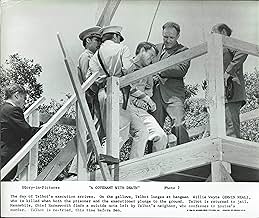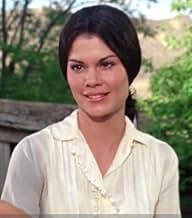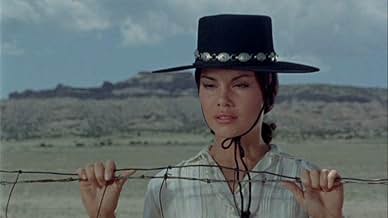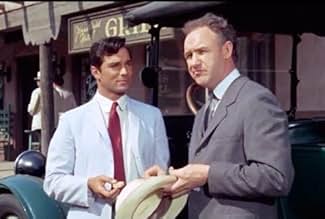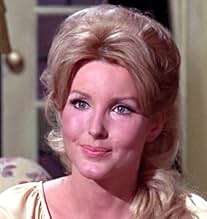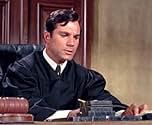Ajouter une intrigue dans votre langueA convicted murderer kills his hangman. Then it is discovered that he actually didn't commit the murder he was convicted for.A convicted murderer kills his hangman. Then it is discovered that he actually didn't commit the murder he was convicted for.A convicted murderer kills his hangman. Then it is discovered that he actually didn't commit the murder he was convicted for.
- Réalisation
- Scénario
- Casting principal
Emilio Fernández
- Ignacio
- (as Emilio Fernandez)
Walter Bacon
- Trial Spectator
- (non crédité)
Al Bain
- Trial Spectator
- (non crédité)
Avis à la une
Normally, I don't complain but the summary on IMDb for this film is pretty bad. First, it discloses a BIG plot twist. Second, it really doesn't explain what the movie really is all about as well. Sure, there is a murder and execution...but it's all through the eyes of a young Hispanic judge (George Maharis) and there's no mention of him or how he relates to all this.
The story actually is a bit dispassionate...or should I say the first portion. Ben (Maharis) observes what's going on but seems surprisingly impassive about it. Later, however, when the case is surprisingly dropped into his lap, he has to become involved and make a decision based not just on law but common sense as it's really hard at this point to find a precedent for what happens.
Aside from the poor decision to cast Maharis (he's a handsome guy but hardly seems Hispanic), the film is an interesting look at justice and kept my interest. Worth seeing.
The story actually is a bit dispassionate...or should I say the first portion. Ben (Maharis) observes what's going on but seems surprisingly impassive about it. Later, however, when the case is surprisingly dropped into his lap, he has to become involved and make a decision based not just on law but common sense as it's really hard at this point to find a precedent for what happens.
Aside from the poor decision to cast Maharis (he's a handsome guy but hardly seems Hispanic), the film is an interesting look at justice and kept my interest. Worth seeing.
As the title would indicate the film makers chose to go the high minded, serious legal and moral issues route rather than the trashier steamy, lurid, small town murder trial route. Bad decision. What results is a fairly stiff, dull movie with a few good performances (i.e. Katy Jurado as a New Mexican aristocrat/feminista, Earl Holliman as the unjustly accused good ol boy and an early Gene Hackman turn as a none too bright, racist sheriff). Especially bad is George Maharis in the lead. It's not so much that you simply don't buy a Greek/American actor from Queens , sporting a very outer borough accent, as a a native New Mexican (leaving aside the obvious objection that 1967, when this film was made, is getting late in the day for Brownface) it's that Maharis cannot for the life of him shed his Buzz Murdock persona from "Route 66" with his constant moral outbursts, tendency to fisticuffs and advocacy of the natural as opposed to the "plastic" life. The hippy/dippy scene where he rejects Laura Devon as a wife because she won't curl and uncurl her toes and walk naked in a supermarket has to be a low point not only in Maharis' career but in that of director Lamont Johnson (who, you would have thought, had already plumbed the depths in "Kona Coast") and scenarists Larry Marcus and Saul Levitt. Solid C.
I DVR'd this film off of TCM's lineup, frankly because I was intrigued by the title. The only cast members' names I recognized were Gene Hackman, Kent Smith, and Earl Holliman. I'm glad I took a chance on this film.
First, if given the chance, I'd like to shake the hand of Mr. George Maharis. What a wonderful performance he delivers. The rest of the cast is fine, too; and there's no doubt in my mind that they cared about this project and wanted to give it their all. The production is slick, although I concede it feels more like a network movie of the week more than it does a full fledged theatrical release.
One of the aspects of the film that really surprises and pleases me is the representation of a then minority group/characters as forerunners of the plotline. The story centers around a Mexican-American, and while the usual stereotypes and cultural appropriation are present here, the fact that the producers took a chance on making it the focus is worthy of praise. Considering it was released in 1967, it deserves recognition for that fact alone.
If you're cool with melodramas from the late 1960s, you'll like this.
First, if given the chance, I'd like to shake the hand of Mr. George Maharis. What a wonderful performance he delivers. The rest of the cast is fine, too; and there's no doubt in my mind that they cared about this project and wanted to give it their all. The production is slick, although I concede it feels more like a network movie of the week more than it does a full fledged theatrical release.
One of the aspects of the film that really surprises and pleases me is the representation of a then minority group/characters as forerunners of the plotline. The story centers around a Mexican-American, and while the usual stereotypes and cultural appropriation are present here, the fact that the producers took a chance on making it the focus is worthy of praise. Considering it was released in 1967, it deserves recognition for that fact alone.
If you're cool with melodramas from the late 1960s, you'll like this.
No need to cover the plot beyond what has already been said. As has also been stated, in many ways this seems like a one-hour teleplay that has been expanded into a feature film. Though billed as a courtroom drama, most of the screen time is taken up with two romantic subplots and a third drama involving the relationship between Maharis and his mother (Jurado).
Maharis is bland as the lead, as are the two women in his life (this is more of a script problem than the actors' faults). Gene Hackman has a fairly small role as the sheriff, so doesn't really get to shine. The one standout, surprisingly, is Earl Holliman. He can often be hammy or wooden, but here he deftly alternates between sympathetic and despicable in the movie's one complex role.
The other standouts in the film are its period setting (early 1900s New Mexico), and the luminous photography by Robert Burks in his next-to-last film.
Maharis is bland as the lead, as are the two women in his life (this is more of a script problem than the actors' faults). Gene Hackman has a fairly small role as the sheriff, so doesn't really get to shine. The one standout, surprisingly, is Earl Holliman. He can often be hammy or wooden, but here he deftly alternates between sympathetic and despicable in the movie's one complex role.
The other standouts in the film are its period setting (early 1900s New Mexico), and the luminous photography by Robert Burks in his next-to-last film.
Thanks to Warner Archive for releasing this film on DVD this past September. It would appear that this film was an attempt to make a major film star out of TV actor George Maharis. His performance as the young, inexperienced judge was very well executed. Earl Holliman shines as the convicted suspect. This is film is noteworthy for an early performance by Gene Hackman as a police officer. His performances echos what would soon come later, in his role as Popye Doyle in "The French Connection," The romance portion of the film may be predictable, but overall the acting is well done, and the photography is great. The best selling novel "A Covenant with Death," by Stephen Becker is given fair treatment in this adaptation. I would defiantly recommend this film ***
Le saviez-vous
- AnecdotesDirector Lamont Johnson had started as an actor, in 1951, and began directing for television in 1957. Pacte avec la mort (1967) was his feature-film directorial debut. He would continue to work in both mediums more or less equally, racking up 11 Emmy nominations and winning the award twice. His best-known works are probably Dialogue de feu (1971), Last American Hero (1973), and the TV movie Exécuté pour désertion (1974).
- GaffesNew Mexico was admitted as a state of the union in 1912. At one point, Ben Lewis notes that New Mexico became a state "a dozen years ago," indicating the movie is set in 1924. But later in the film, we see a letter being written that bears the date, "July 8, 1923."
Meilleurs choix
Connectez-vous pour évaluer et suivre la liste de favoris afin de recevoir des recommandations personnalisées
- How long is A Covenant with Death?Alimenté par Alexa
Détails
- Durée1 heure 37 minutes
- Mixage
- Rapport de forme
- 1.85 : 1
Contribuer à cette page
Suggérer une modification ou ajouter du contenu manquant


